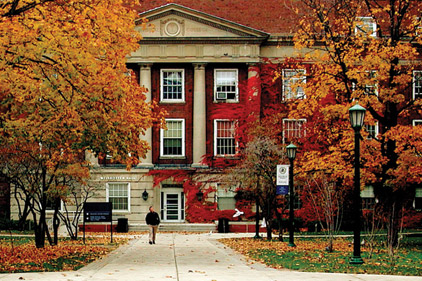
|
| Weiskotten Hall at SUNY Upstate Medical University in Syracuse, N.Y., is one of many state-owned buildings undergoing HVAC improvements through Build Smart NY – a statewide initiative to increase energy efficiency 20 percent by 2020. |
On Dec. 28, 2012, New York Gov. Andrew Cuomo signed an executive order mandating a 20 percent increase in energy efficiency in state buildings by 2020. Coinciding with his executive order was the launch of Build Smart NY — a strategic plan to implement the order over the next seven years.
In addition to saving energy and reducing pollution, Cuomo hopes the initiative will also generate thousands of jobs, stimulate the economy, and save the state money in the long run.
Build Smart NY
The program is first targeting the most energy-inefficient buildings, which will undergo comprehensive whole-building improvements, including new lighting fixtures and controls, HVAC systems, electric motors, and automated energy management systems.
To help support the initiative, the New York Power Authority (NYPA) has made available $450 million in low-cost financing, which, in most cases, can be repaid without capital spending through the project’s energy savings. The New York State Energy Research and Development Authority (NYSERDA) is also involved in Build Smart NY, providing energy-efficiency programs and financial incentives to help offset the cost of improvements.
“Improving energy efficiency in our buildings is a smart investment in our present and future,” Cuomo said. “Through Build Smart NY, state government can produce significant savings for New York taxpayers and generate thousands of jobs while reducing greenhouse gas emissions by more than 8 million metric tons, which is the same as taking 1 million cars off the road for one year. Furthermore, most of the projects will pay for themselves as their energy savings will cover their costs, making this initiative a financial and environmental win-win for New Yorkers.”
So far, energy-use data has been collected on more than 180 million square feet of buildings and campuses in the state — roughly 95 percent of the state’s building stock — and work has already begun on 30 million square feet of real estate.
More Projects, More Jobs
With Build Smart NY already underway, New York contractors are finding ways to become involved in the initiative’s numerous projects. Syracuse, N.Y.-based Tag Mechanical Systems Inc. is involved in one such project at the State University of New York (SUNY) Upstate Medical University. “Certainly, if there’s an opportunity, we’re going to take it,” said Ellis Guiles, TAG Mechanical vice president. “Conceptually, Build Smart NY is a good idea.”
Phase IV of the project at SUNY Upstate Medical University includes lighting upgrades, installation of lighting sensors and controls, HVAC upgrades, electric motor replacement, energy management system upgrades, steam-trap replacement, variable-frequency drives (VFDs), and a compressed air system. The $4.9 million project began in May 2012 and, once completed, is projected to save nearly $355,000 each year in energy costs, according to the Build Smart NY website. It is funded using loans provided by NYPA.
Domenic DeLeo, department manager for Isaac Home Energy Performance, Rochester, N.Y., also said he thinks Build Smart NY has a lot of potential, both for contractors and residents. “It seems like a good idea,” DeLeo said. “They’re finally putting tax dollars to work for us. It should pay for itself and then some.”
DeLeo said Build Smart NY projects provide an opportunity for taxpayers to see firsthand the monetary and environmental advantages of making energy-efficiency improvements to their own homes, which could lead to more residential and commercial projects for contractors in the future.
“It’s all based on data, and it’s all proven,” he said. “Before you make the improvement, you know what the payback will be.”
While Guiles and DeLeo see the potential in Build Smart NY, they admit to not yet knowing the degree to which it will affect HVACR contractors.
“It depends on how this plays out and who works on it,” Guiles said. “With any of these state programs we see come about, part of what ends up causing challenges is that we’re not always aware of them. Trying to figure out what projects are going on, and where, can be challenging to keep track of.”
“We do a similar program on the residential level right now,” DeLeo said. “I think, down the road, there should be a lot of opportunities to do this on a commercial level.”
Leading by Example
While many states currently have energy-saving policies in place, Build Smart NY is already being lauded by some as one of the most aggressive lead-by-example energy-saving initiatives in the country.
Nicole Steele, policy and research program manager for the Alliance to Save Energy (ASE), said the initiative is definitely a big deal. “I think this is one of the first statewide efforts to really increase energy efficiency in a short amount of time,” Steele said. “We think it’s a great example of state and local governments leading by example and creating problem-solving policies that can be elevated to the national level and transform the market and our economy.”
Jennifer Amann, buildings program director for the American Council for an Energy-Efficient Economy (ACEEE), agreed that Cuomo’s initiative could spur more projects at the local level.
“It’s a great thing, and it’s building on things we’ve seen work in the private sector, so there’s an indication that it’s not just an initiative that sounds like a good idea. There’s a track record and a reason to believe it can be successful,” Amann said. “It’s a great idea for a state to take this on, and it’s a wise use of public resources. If the state government can do it at their level, then they can show how it can be done at the local level. It’s a great way for them to showcase what’s possible.”
Steele agreed. “We are excited that New York has moved forward to put together very aggressive goals. It’s leading by example,” she said. “We hope other states follow its lead.”
For more information about Build Smart NY, or to view current Build Smart NY projects, visit www.buildsmart.ny.gov.
Publication date: 4/1/2013









